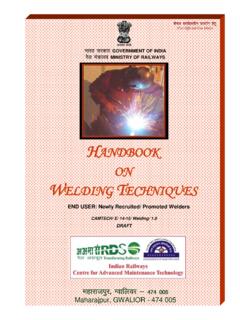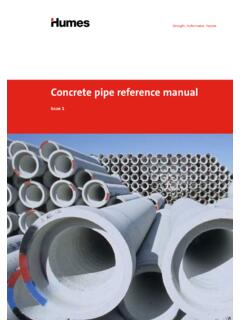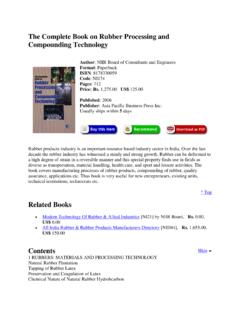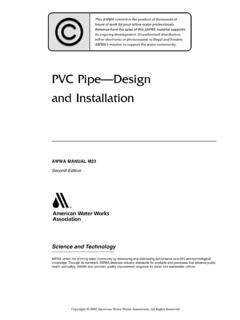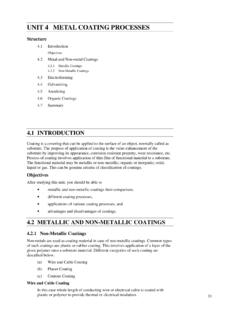Transcription of U.S. DEPARTMENT OF LABOR Occupational Safety and …
1 ABSTRACT-1 DEPARTMENT OF LABOR Occupational Safety and Health Administration DIRECTIVE NUMBER: CPL 03-00-008 EFFECTIVE DATE: 3/11/08 SUBJECT: Combustible Dust National Emphasis Program (Reissued) **NOTE: As a result of the March 26, 2012, revision to OSHA s Hazard Communication Standard, minor changes {in brackets} were made to this directive on October 1, 2015. These changes do not impact this directive s enforcement policy. ABSTRACT Purpose: This instruction contains policies and procedures for inspecting workplaces that create or handle combustible dusts. In some circumstances these dusts may cause a deflagration, other fires, or an explosion. These dusts include, but are not limited to: Metal dust such as aluminum and magnesium. Wood dust Coal and other carbon dusts. Plastic dust and additives Biosolids Other organic dust such as sugar, flour, paper, soap, and dried blood.
2 Certain textile materials Scope: This instruction applies OSHA-wide. References: See paragraph III. Cancellations: This directive cancels OSHA Instruction CPL 03-00-006 Combustible Dust National Emphasis Program, October 18, 2007. State Plan Impact: Notice of Intent required. See paragraph VI. Action Offices: National, Regional, and Area Offices. Originating Office: Directorate of Enforcement Programs. ABSTRACT-2 Contact: Directorate of Enforcement Programs 200 Constitution Avenue, NW, Room N3107 Washington, DC 20210 Phone: (202) 693-1850 By and Under the Authority of Edwin G. Foulke, Jr. Assistant Secretary ABSTRACT-3 Executive Summary OSHA is reissuing the directive on the Combustible Dust National Emphasis Program to increase its enforcement activities and to focus on specific industry groups that have experienced either frequent combustible dust incidents or combustible dust incidents with catastrophic consequences.
3 OSHA initiated its previous Combustible Dust National Emphasis Program on October 18, 2007. As a result of a recent catastrophic accident involving a combustible dust explosion at a sugar refinery, OSHA has decided to intensify its focus on this hazard. The Agency will increase its activities in outreach, training, the creation and dissemination of guidance and educational materials and cooperative ventures with stakeholders, as well as enhancing its enforcement activities through this amendment to the National Emphasis Program. The purpose of this NEP is to inspect facilities that generate or handle combustible dusts which pose a deflagration or other fire hazard when suspended in air or some other oxidizing medium over a range of concentrations, regardless of particle size or shape; deflagrations can lead to explosions. Combustible dusts are often either organic or metal dusts that are finely ground into very small particles, fibers, fines, chips, chunks, flakes, or a small mixture of these.
4 Types of dusts include, but are not limited to: metal dust, such as aluminum and magnesium; w ood dust; plastic dust; biosolids; organic dust, such as sugar, paper, soap, and dried blood; and dusts from certain textiles. Some industries that handle combustible dusts include: agriculture, c hemicals, textiles, f orest and furniture products, wastewater treatment, metal processing, paper products, pharmaceuticals, and recycling operations (metal, paper, and plastic). In situations where the facility being inspected is not a grain handling facility, the lab results indicate that the dust is combustible, and the combustible dust accumulations not contained within dust control systems or other containers, such as storage bins, are extensive enough to pose a deflagration, explosion, or other fire hazard, then citations under 29 CFR (housekeeping) or, where appropriate, 29 CFR (c) (housekeeping in storage areas) may generally be issued.
5 Combustible dusts found in grain handling facilities are covered by 29 CFR For workplaces not covered by , but where combustible dust hazards exist within dust control systems or other containers, c itations under section 5(a)(1) of the OSH Act (the General Duty Clause) may generally be issued for deflagration, other fire, or explosion hazards. National Fire Protection Association (NFPA) standards ( listed in Appendix A of this directive) should be consulted to obtain evidence of hazard recognition and feasible abatement methods. Other standards are applicable to the combustible dust hazard. For example, if the workplace has a Class II location, then citations under 29 CFR may be issued to those employers having electrical equipment not meeting the standard s requirements. ABSTRACT-4 New Directive: Significant Issues This is a new directive replacing the previously issued directive, OSHA Instruction CPL03-00-006, issued on October 18, 2007, which described the policies and procedures regarding inspection of facilities that handle combustible dust.
6 This directive does not replace the grain handling facility directive, OSHA Instruction CPL 02-01-004, Inspection of Grain Handling Facilities, 29 CFR In addition, this directive is not intended for inspections of explosives and pyrotechnics manufacturing facilities covered by the Process Safety Management (PSM) standard ( ). However, it does not exclude facilities that manufacture or handle other types of combustible dusts (such as ammonium perchlorate) covered under the PSM standard. i TABLE OF CONTENTS I. Purpose .. 1 II. Scope.. 1 III. References .. 1 IV. Action .. 2 V. Application .. 2 VI. Federal Program Change .. 3 VII. Background .. 3 VIII. Definitions .. 4 IX. Program Procedures .. 6 A. Inspection Scheduling .. 6 B. Scheduling and Resource Allocation .. 7 C. Opening Conference .. 8 D. Inspection Resources .. 8 E. Inspection and Citation Procedures.
7 11 F. Program Evaluation .. 23 G. Outreach .. 23 H. IMIS Coding Instructions .. 24 X. Appendices .. 24 Appendix A .. A-1 Appendix B .. B-1 Appendix C .. C-1 Appendix D-1 and D-1 Appendix E .. E-1 1 I. Purpose. This instruction contains policies and procedures for inspecting workplaces that handle combustible dusts that are likely to cause dust deflagrations, other fires, or explosions. These dusts include, but are not limited to: Metal dust such as aluminum and magnesium. Wood dust Coal and other carbon dusts Plastic dust and additives Biosolids Other organic dust such as sugar, flour, paper, soap, and dried blood. Certain textile materials. Industries that handle combustible dusts include, but are not limited to: Agriculture Food Products Chemicals Textiles Forest and furniture products Metal processing Tire and rubber manufacturing plants Paper products Pharmaceuticals Wastewater treatment Recycling operations ( metal, paper, and plastic.)
8 Coal dust in coal handling and processing facilities. (Note: OSHA Standard 29 CFR (v)(11)(xii) addresses control of ignition sources at coal handling operations in electric power plants. The Mine Safety and Health Administration (MSHA) has authority in some areas involving coal crushing and conveying. See OSHA Instruction CPL 02-01-038 dated June 18, 2003 for additional guidance on authority) II. Scope. This instruction applies OSHA-wide. III. References. A. OSHA Regional Notice (Region III), Directive Number: 2006 - 556 (CPL 04), Local Emphasis Program for Dust Explosion Prevention, October 1, 2006. B. OSHA Instruction CPL 02-00-103, Field Inspection Reference Manual, September 26, 1994. C. OSHA Instruction CPL 02-01-004, Inspection of Grain Handling Facilities, 29 CFR , November 8, 1996. D. OSHA Instruction CPL 02-01-038, Enforcement of the Electric Power Generation, Transmission, and Distribution Standard, June 18, 2003.
9 2 E. Safety and Health Information Bulletin (SHIB)--Improper Installation of Wood Dust Collectors in the Woodworking Industry May 2, 1997. F. SHIB--Combustible Dust in Industry: Preventing and Mitigating the Effects of Fire a nd Explosions July 31, 2005. G. 29 CFR applicable to Subpart S Electrical. H. NFPA 61, Standard for the Prevention of Fires and Dust Explosions in Agricultural and Food Processing Facilities (2002 Edition). I. NFPA 68, Guide for Venting of Deflagrations (2002 Edition). J. NFPA 69, Standard on Explosion Prevention Systems (2002 Edition). K. NFPA 70, National Electrical Code (2005). L. NFPA 77, Recommended Practice on Static Electricity. M. NFPA 86, Standard for Ovens and Furnaces. N. NFPA 120, Standard for Fire Prevention and Control in Coal Mines. O. NFPA 91, Standard for Exhaust Systems for Air Conveying of Vapors, Gases, Mists, and Noncombustible Particulate Solids (2004 Edition).
10 P. NFPA 484, Standard for Combustible Metals (2006 Edition). Q. NFPA 499, Recommended Practice for the Classification of Combustible Dusts and of Hazardous (Classified) Locations for Electrical Installations in Chemicals Process Areas (2004 Edition). R. NFPA 654, Standard for the Prevention of Fires and Dust Explosions from the Manufacturing, Processing, and Handling of Combustible Particulate Solids (2006 Edition). S. NFPA 664, Standard for the Prevention of Fires and Explosions in Wood Processing and Woodworking Facilities ( 2007 Edition). T. NFPA 2113, Standard on Selection, Care, Use and Maintenance of Flame-Resistant Garments for Protection of Industrial Personnel Against Flash Fire. U. ASTM E1226 05, Standard Test Method for Pressure and Rate of Pressure Rise for Combustible Dusts. V. ASTM E1515, Standard Test Method for Minimum Explosible Concentration of Combustible Dusts.










